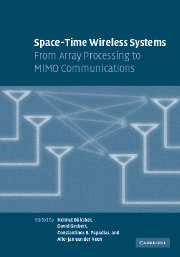Book contents
- Frontmatter
- Contents
- List of contributors
- Acknowledgments
- Introduction
- Part I Multiantenna basics
- 1 Propagation aspects of MIMO channel modeling
- 2 Beamforming techniques
- 3 Diversity in wireless systems
- 4 Fundamentals of MIMO channel capacity
- 5 Multiantenna capacity: myths and realities
- 6 The role of feedback, CSI, and coherence in MIMO systems
- Part II Space-time modulation and coding
- Part III Receiver algorithms and parameter estimation
- Part IV System-level issues of multiantenna systems
- Part V Implementations, measurements, prototypes, and standards
- Index
3 - Diversity in wireless systems
Published online by Cambridge University Press: 25 February 2010
- Frontmatter
- Contents
- List of contributors
- Acknowledgments
- Introduction
- Part I Multiantenna basics
- 1 Propagation aspects of MIMO channel modeling
- 2 Beamforming techniques
- 3 Diversity in wireless systems
- 4 Fundamentals of MIMO channel capacity
- 5 Multiantenna capacity: myths and realities
- 6 The role of feedback, CSI, and coherence in MIMO systems
- Part II Space-time modulation and coding
- Part III Receiver algorithms and parameter estimation
- Part IV System-level issues of multiantenna systems
- Part V Implementations, measurements, prototypes, and standards
- Index
Summary
Introduction
The main impairment in wireless channels is fading or random fluctuation of the signal level. This signal fluctuation happens across time, frequency, and space. Diversity techniques provide the receiver with multiple independent looks at the signal to improve reception. Each one of those independent looks is considered a diversity branch. The probability that all diversity branches will fade at the same time goes down as the number of branches increases. Hence, with a high probability, there will be at least one branch or link with a good signal such that the transmitted data can be detected reliably.
Wireless channels are, in general, characterized by frequency-selective multipath propagation, Doppler-induced time-selective fading, and spaceselective fading. An emitted signal propagating through the wireless channel is reflected and scattered from a large number of scatterers, thereby arriving at the receiver through different paths and hence arriving at different times. This results in the time dispersion of the transmitted signal. A measure of this dispersion is called the channel delay spread Tmax. The coherence bandwidth of the channel Bc ≈ l/Tmax measures the frequency bandwidth over which the propagation channel remains correlated. Therefore, a propagation channel with a small delay spread will have a large coherence bandwidth, i.e., the channel frequency response will remain correlated over a large bandwidth, and vice versa.
In addition, transmitter and receiver mobility as well as changes in the propagation medium induce time variations in the propagation channel.
- Type
- Chapter
- Information
- Space-Time Wireless SystemsFrom Array Processing to MIMO Communications, pp. 44 - 65Publisher: Cambridge University PressPrint publication year: 2006



